Characteristic Analysis of Occupational Confined Space Accidents in Taiwan and Its Prevention Strategy
Abstract
1. Introduction
2. Materials and Methods
2.1. Subjects
2.2. Data Collection
2.3. Data Analysis
3. Results and Discussion
3.1. Characterization of Fatal Work Accidents in Confined Spaces in Taiwan
3.1.1. Period of the Year
3.1.2. Type of Accident
4. Conclusions
Author Contributions
Funding
Conflicts of Interest
References
- Health and Safety Executive (HSE). Guidance on Permit-to-Work Systems: A Guide for the Petroleum, Chemical and Allied Industries; HSE: Bootle, UK, 2005.
- Health and Safety Executive (HSE). Confined Spaces: A Brief Guide to Working Safely; HSE: Bootle, UK, 2014.
- Health and Safety Executive (HSE). Safe Work in Confined Spaces: Confined Spaces Regulations, 3rd ed.; HSE: Bootle, UK, 2014.
- Pettit, T.A.; Braddee, R.W.; Suruda, A.J.; Castillo, D.N.; Helmkamp, J.C. Worker deaths in confined spaces. Prof. Saf. 1996, 41, 22–24. [Google Scholar]
- Kim, Y.R.; Jeong, B.Y.; Park, M.Y. Effects of job satisfaction, organizational support and risk perception on safety consciousness in confined space workers. J. Ergon. Soc. Korea 2017, 36, 245–254. [Google Scholar]
- American National Standards Institute (ANSI). Safety Requirements for Confined Spaces; ANSI\ASSE Z117.1: Des Plaines, IL, USA, 2003. [Google Scholar]
- OSHA (USA). Permit-Required Confined Spaces for General Industry (2.29 C.F.R., 1910.146); OSHA, US Department of Labor: Washington, DC, USA, 1993.
- National Institute for Occupational Safety and Health (NIOSH). Worker Deaths in Confined Spaces; NIOSH: Washington, DC, USA, 1994.
- Wu, H.C. Hazard Evaluation of Confined Space in Wastewater Treatment Facilities Case Studies. Master’s Thesis, National Chung Hsing University, Taichung, Taiwan, 2014. [Google Scholar]
- Wilson, M.P.; Madison, H.N.; Healy, S.B. Confined space emergency response: Assessing employer and fire department practices. J. Occup. Environ. Hyg. 2012, 9, 120–128. [Google Scholar] [CrossRef] [PubMed]
- Burlet-Vienney, D.; Chinniah, Y.; Bahloul, A.; Roberge, B. Occupational safety during interventions in confined spaces. Saf. Sci. 2015, 79, 19–28. [Google Scholar] [CrossRef]
- Ministry of Labor (Taiwan). Occupational Safety and Health Facilities Regulation; Ministry of Labor Taiwan: Taipei, Taiwan, 2019.
- National Institute for Occupational Safety and Health (NIOSH). A Guide to Safety in Confined Spaces; NIOSH: Washington, DC, USA, 1987.
- Ministry of Labor (Taiwan). Regulations for Prevention of Hypoxia; Ministry of Labor Taiwan: Taipei, Taiwan, 2014.
- Taylor, B. Confined Spaces Common Misconceptions & Errors in Complying with OSHA’s Standard; American Society of Safety Professionals (ASSP): Park Ridge, IL, USA, 2011. [Google Scholar]
- Institute of Labor, Occupational Safety and Health (ILOSH). Application Study of Incident Investigation Method; ILOSH, Ministry of Labor Taiwan: New Taipei City, Taiwan, 2010.
- Kakhki, F.D.; Freeman, S.A.; Mosher, G.A. Segmentation of severe occupational incidents in agribusiness industries using latent class clustering. Appl. Sci. 2019, 9, 3641. [Google Scholar] [CrossRef]
- Bevilacqua, M.; Ciarapica, F.E.; Giacchetta, G. Industrial and occupational ergonomics in the petrochemical process industry: A regression trees approach. Accid. Anal. Prev. 2008, 40, 1468–1479. [Google Scholar] [CrossRef] [PubMed]
- Shafique, M.; Rafiq, M. An overview of construction occupational accidents in Hong Kong: A recent trend and future perspectives. Appl. Sci. 2019, 9, 2069. [Google Scholar] [CrossRef]
- Burnham, K.P.; Anderson, D.R. Multimodel inference: Understanding AIC and BIC in model selection. Sociol. Methods Res. 2004, 33, 261–304. [Google Scholar] [CrossRef]
- Emanuele, C.F. Big data analytics as a tool for reducing ergonomics risk. J. Ergon. 2017, 7, 1000. [Google Scholar] [CrossRef]
- OSHA (Taiwan). Occupational Accidents Cases; OSHA, Ministry of Labor Taiwan: New Taipei City, Taiwan, 2018.
- Katsakiori, P.; Sakellaropoulos, G.; Manatakis, E. Towards an evaluation of accident investigation methods in terms of their alignment with accident causation models. Saf. sci. 2009, 47, 1007–1015. [Google Scholar] [CrossRef]
- OSHA (Taiwan). 2009 Annual Reports of Labor Inspection; OSHA, Ministry of Labor Taiwan: New Taipei City, Taiwan, 2009.
- OSHA (Taiwan). 2010 Annual Reports of Labor Inspection; OSHA, Ministry of Labor Taiwan: New Taipei City, Taiwan, 2010.
- Ciaran, M.C. Confined Space Fatalities; Edith Cowan University: Perth, WA, Australia, 2006. [Google Scholar]
- Jovanovic, J.; Arandelovic, M.; Jovanovic, M. Multidisciplinar aspects of occupational accident and injuries. Facta Univ. Ser. Work. Living Environ. Prot. 2004, 2, 325–333. [Google Scholar]
- Bird, F.E., Jr.; Germain, G.L. Practical Loss Control Leadership; International Loss Control Institute: Loganville, GA, USA, 1985; ISBN 0-88061-054-9. [Google Scholar]
- Yao, P.L. Occupation Incident Investigation Technique. Master’s Thesis, National Central University, Taoyuan, Taiwan, 2009. [Google Scholar]
- Center for Chemical Process Safety (CCPS). Guidelines for Investigating Chemical Process Incidents, 3rd ed.; CCPS, AIChE: New York, NY, USA, 2019. [Google Scholar]
- Council of Labor Affairs (Taiwan). 2009 Occupational Safety and Health Promotion Program; Executive Yuan: Taipei, Taiwan, 2009.
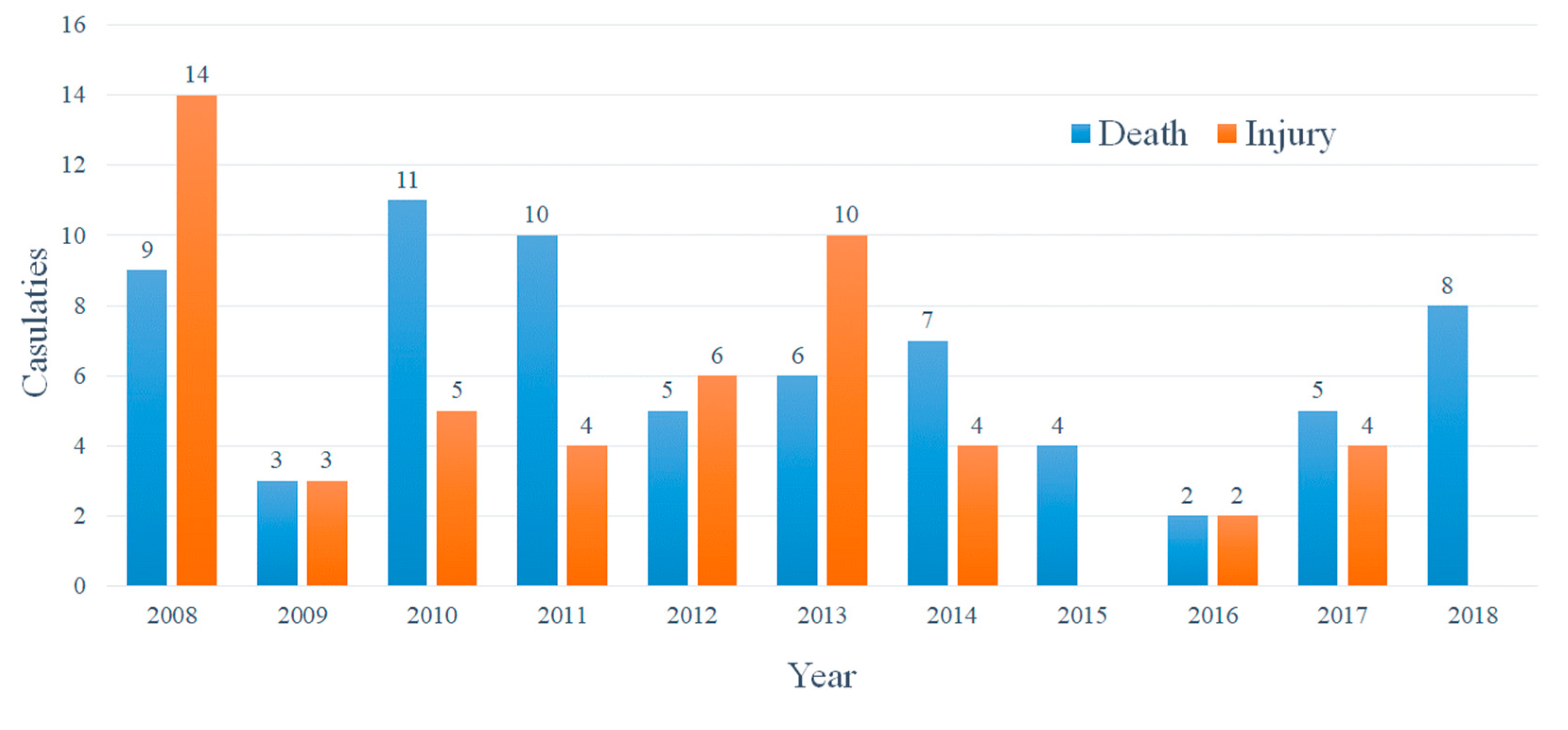
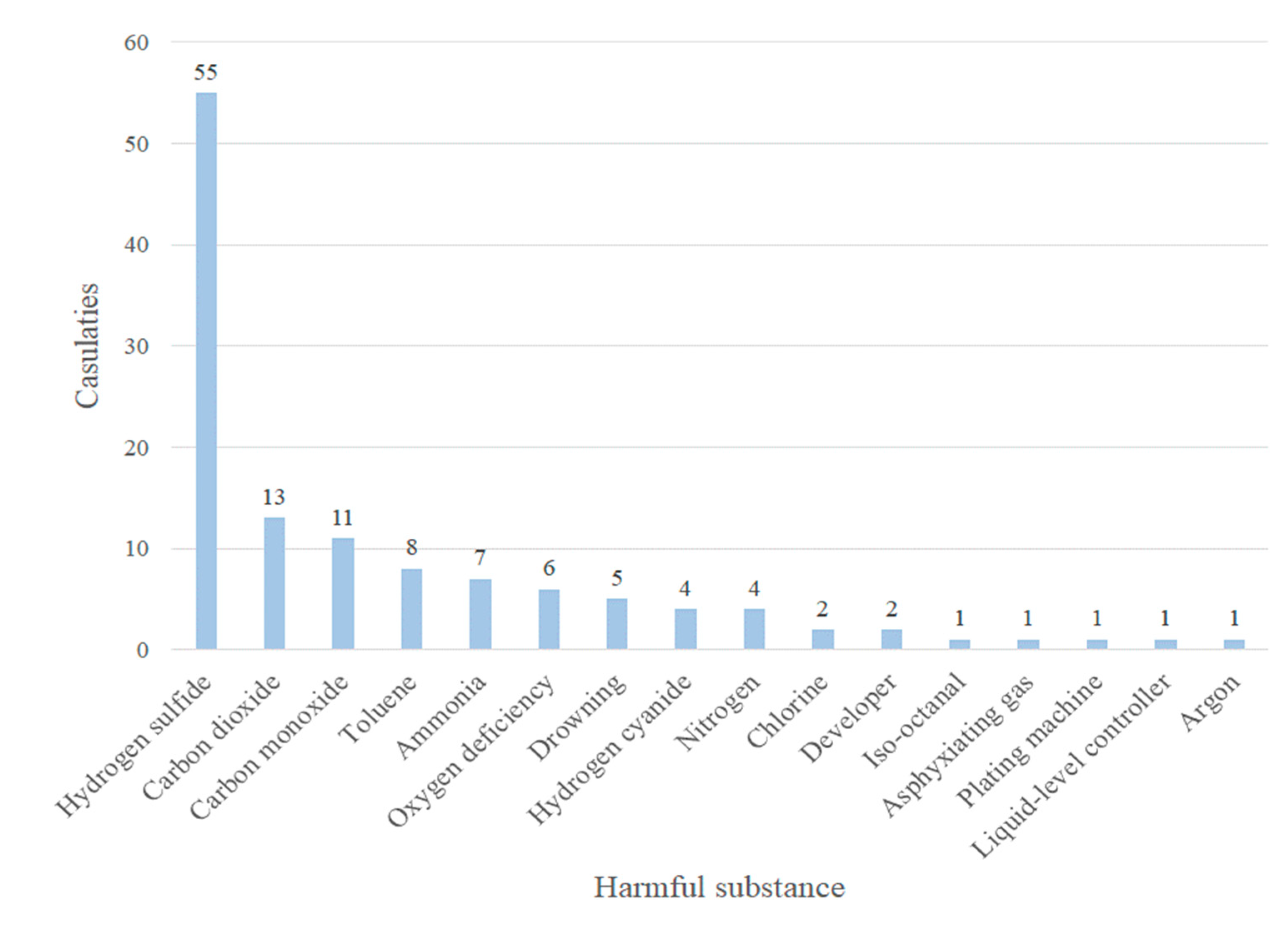

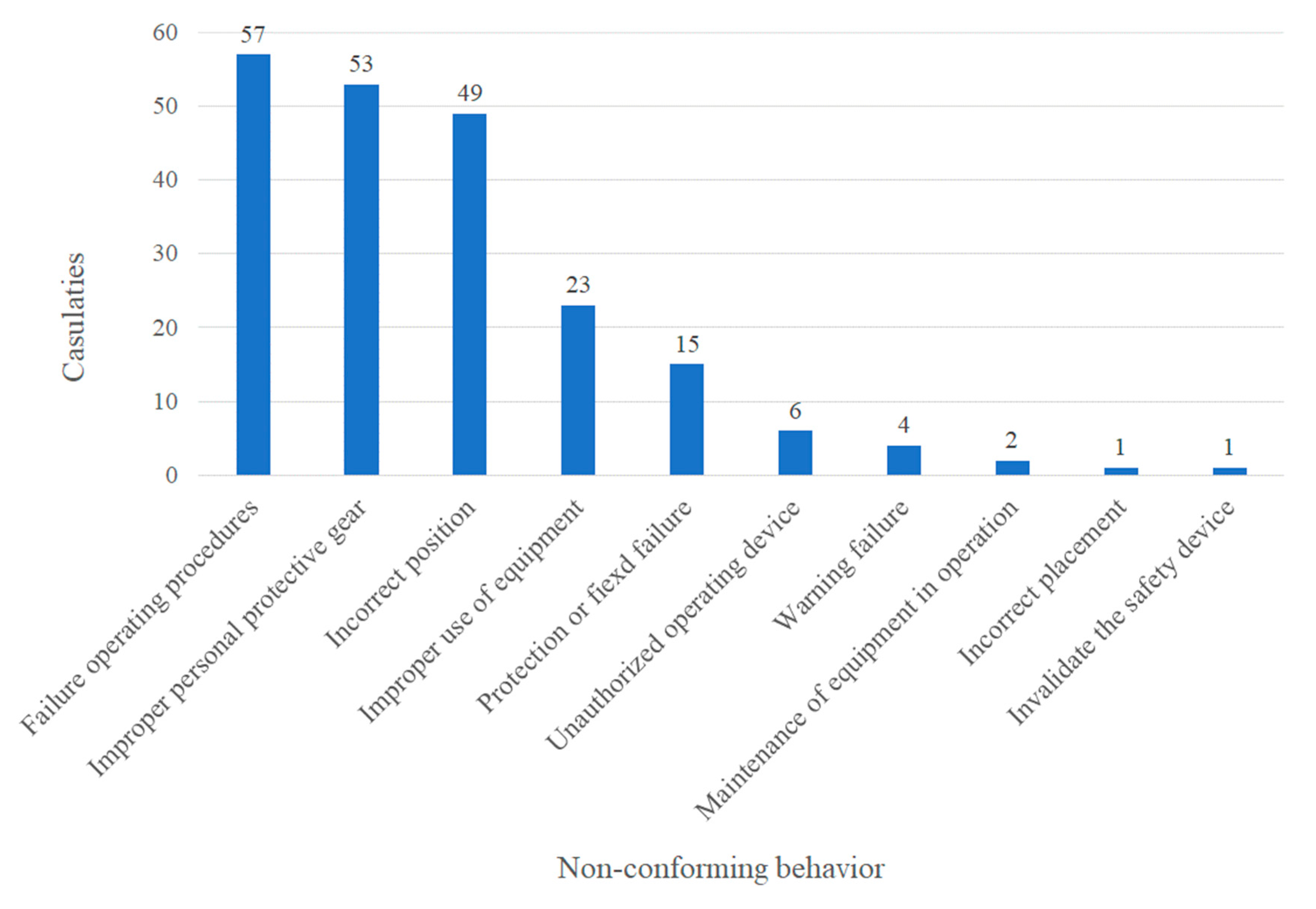
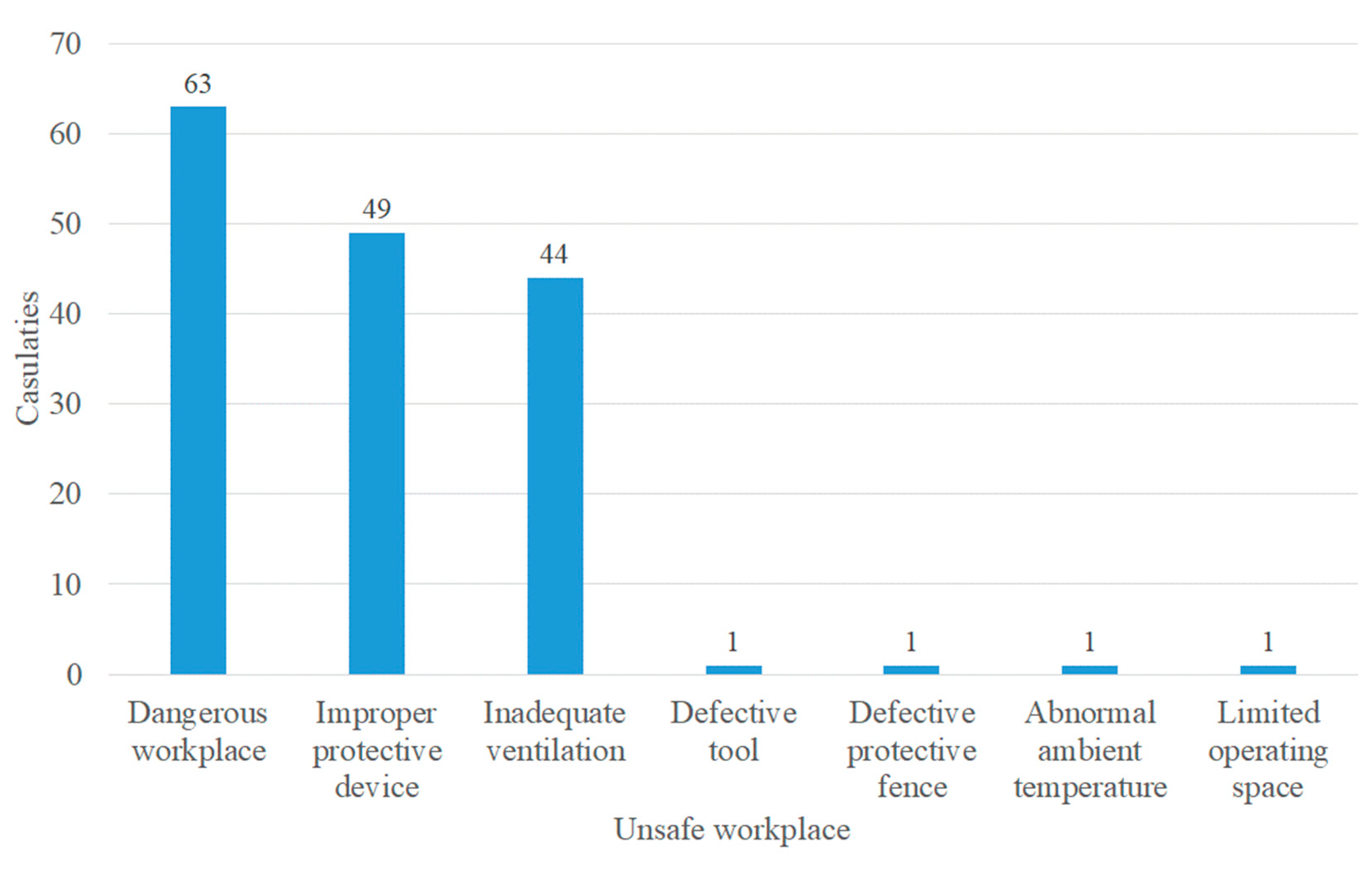
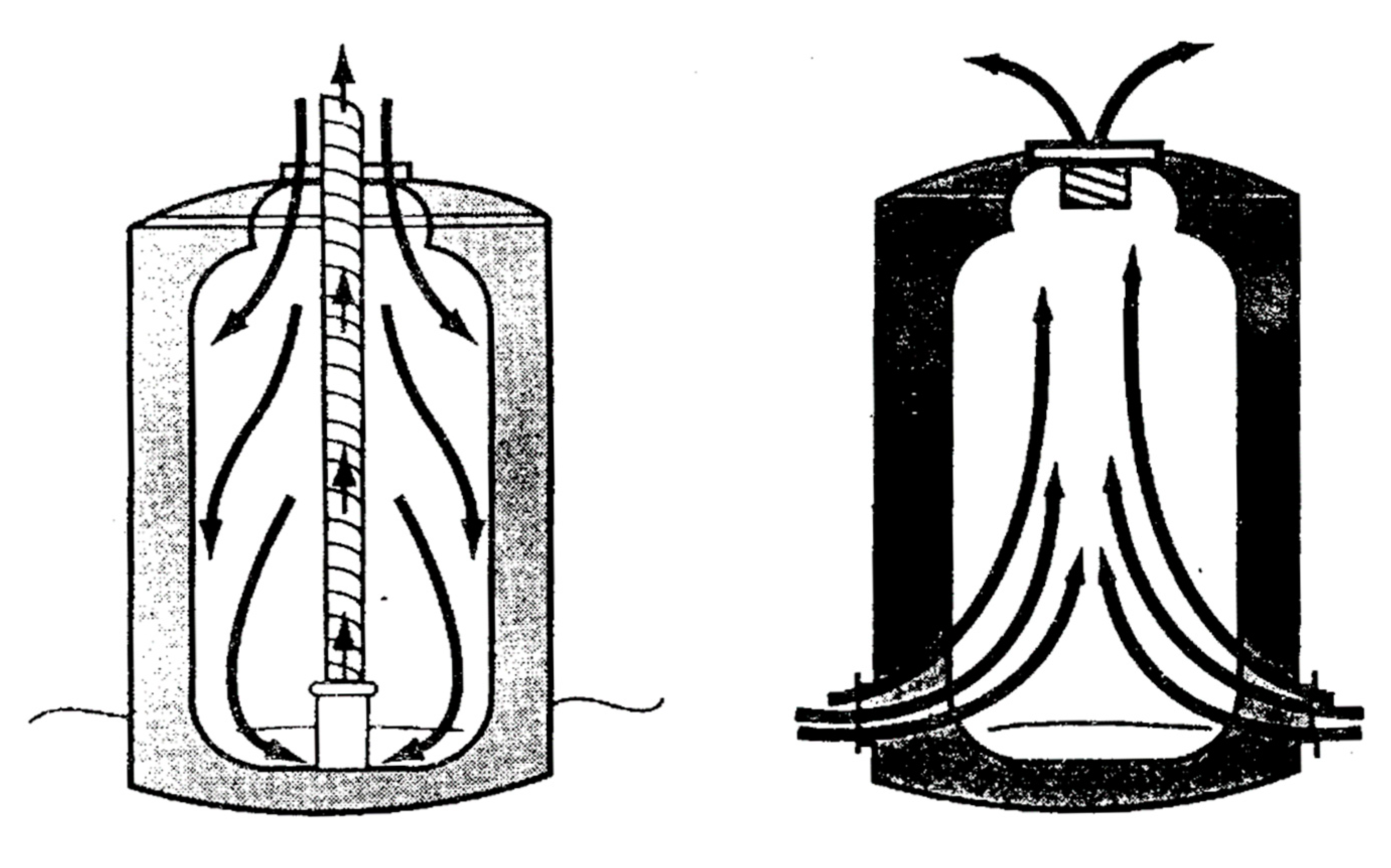
| Business | Medium | Accident Type | Time of Occurrence | Death | Injury |
|---|---|---|---|---|---|
| Interior decoration and repair | Harmful substance (toluene) | Contact with harmful substance | 2008 | 2 | |
| Mechanical and electrical maintenance | Harmful substance (carbon monoxide) | Contact with harmful substance | 2008 | 2 | |
| Interior decoration and repair | Harmful substance (carbon monoxide) | Contact with harmful substance | 2008 | 3 | |
| Interior decoration and repair | Harmful substance (toluene) | Contact with harmful substance | 2008 | 2 | |
| Wholesale, repair, and installation construction of firefighting equipment | Harmful substance (carbon dioxide) | Contact with harmful substance | 2008 | 6 | |
| Environmental protection engineering | Other (nitrogen) | Contact with harmful substance | 2008 | 1 | |
| Manufacture of other chemical products | Harmful substance (hydrogen sulfide) | Contact with harmful substance | 2008 | 1 | |
| Casting of iron and steel | Harmful substance (carbon monoxide) | Contact with harmful substance | 2008 | 1 | |
| Raising of swine/pigs | Harmful substance (carbon monoxide, etc.) | Contact with harmful substance | 2008 | 1 | |
| Mechanics, telecommunications, and electrical engineering, security service activities | Harmful substance (carbon monoxide, etc.) | Contact with harmful substance | 2008 | 2 | |
| Building maintenance and upholstery | Harmful substance (toluene) | Contact with harmful substance | 2008 | 2 | |
| Wastewater and sewage treatment | Harmful substance (hydrogen sulfide) | Contact with harmful substance | 2009 | 3 | |
| Wholesale of electrical equipment | Harmful substance (developer) | Contact with harmful substance | 2009 | 2 | |
| Manufacture of semiconductors | Other (nitrogen) | Contact with harmful substance | 2009 | 1 | |
| Electrical equipment | Harmful substance (ammonia) | Contact with harmful substance | 2010 | 1 | |
| Pipeline engineering | Harmful substance (hydrogen sulfide) | Contact with harmful substance | 2010 | 1 | |
| Processing of fish, crustaceans, and mollusks | Harmful substance (hydrogen sulfide) | Contact with harmful substance | 2010 | 2 | 4 |
| Manufacture of other leather and fur products | Harmful substance (hydrogen sulfide) | Contact with harmful substance | 2010 | 5 | |
| Other special-purpose machinery manufacturing and repair | Harmful substance (hydrogen sulfide) | Contact with harmful substance | 2010 | 1 | 1 |
| Casting of iron and steel | Harmful substance (carbon monoxide) | Contact with harmful substance | 2010 | 1 | |
| Manufacture of other rubber products | Harmful substance (hydrogen sulfide) | Contact with harmful substance | 2011 | 1 | 1 |
| Manufacture of basic chemicals | Other (nitrogen) | Contact with harmful substance | 2011 | 1 | |
| Manufacture of basic chemicals | Other (nitrogen) | Contact with harmful substance | 2011 | 1 | |
| Manufacture of other chemical products | Harmful substance (ammonia) | Contact with harmful substance | 2011 | 1 | |
| Slaughtering | Harmful substance (Hydrogen sulfide) | Contact with harmful substance | 2011 | 1 | 1 |
| Manufacture of bare printed circuit boards | Other (plating machine) | Drowning | 2011 | 1 | |
| Raising of swine/pigs | Harmful substance (hydrogen sulfide) | Contact with harmful substance, etc. | 2011 | 1 | |
| Environment technical testing | Water | Drowning | 2011 | 1 | |
| Treatment of metal surface | Harmful substance (hydrogen cyanide) | Contact with harmful substance, etc. | 2011 | 3 | 1 |
| Other (manufacture of fertilizers) | Harmful substance (carbon dioxide) | Contact with harmful substance | 2012 | 1 | |
| Interior decoration and repair | Harmful substance (toluene) | Contact with harmful substance | 2012 | 2 | |
| Warehousing and storage | Harmful substance (carbon dioxide) | Contact with harmful substance | 2012 | 1 | |
| Food industry | Harmful substance (carbon monoxide) | Contact with harmful substance | 2012 | 1 | |
| Wastewater (sewage) treatment | Harmful substance (hydrogen sulfide) | Contact with harmful substance | 2012 | 1 | |
| Pipeline construction | Harmful substance (hydrogen sulfide) | Contact with harmful substance | 2012 | 3 | |
| Treatment of metal surface | Water | Drowning | 2012 | 1 | |
| Wastewater (sewage) treatment | Water | Drowning | 2012 | 1 | |
| Manufacture of screws, nuts, and rivets | Harmful substance (argon) | Contact with harmful substance | 2013 | 1 | |
| Manufacture of petroleum and coal products | Harmful substance (hydrogen sulfide) | Contact with harmful substance | 2013 | 1 | 3 |
| Treatment of metal surface | Harmful substance (chlorine) | Contact with harmful substance | 2013 | 2 | |
| Other specialized construction activities | Other (oxygen deficiency) | Contact with harmful substance | 2013 | 2 | |
| Wastewater (sewage) treatment | Harmful substance (hydrogen sulfide) | Contact with harmful substance | 2013 | 2 | |
| Manufacture of other non-metallic mineral products | Water | Drowning | 2013 | 1 | |
| Manufacture of beer | Harmful substance (carbon dioxide) | Contact with harmful substance, etc. | 2013 | 3 | |
| Manufacture of beer | Other (oxygen deficiency) | Contact with harmful substance, etc. | 2013 | 1 | |
| Manufacture of paper | Water | Drowning | 2014 | 1 | |
| Petrochemical manufacturing | Harmful substance (iso-octanol, etc.) | Contact with harmful substance, etc. | 2014 | 1 | |
| Wastewater (sewage) treatment | Harmful substance (hydrogen sulfide) | Contact with harmful substance, etc. | 2014 | 1 | |
| Manufacture of other chemical products | Other (oxygen deficiency) | Contact with harmful substance, etc. | 2014 | 1 | |
| Fire protection engineering | Harmful substance (carbon dioxide) | Contact with harmful substance, etc. | 2014 | 1 | 1 |
| Construction of other civil engineering projects | Harmful substance (hydrogen sulfide) | Contact with harmful substance | 2014 | 1 | 1 |
| Sewage work | Harmful substance (ammonia) | Contact with harmful substance | 2014 | 1 | 2 |
| Renting and leasing of agricultural and other industrial machinery and equipment | Electric transmission and distribution wire (liquid-level controller control wire) | Electric shock | 2015 | 1 | |
| Construction | Harmful substance (hydrogen sulfide) | Contact with harmful substance | 2015 | 2 | |
| Wastewater (sewage) treatment | Harmful substance (hydrogen sulfide) | Contact with harmful substance | 2015 | 1 | |
| Mechanics, telecommunications, and electrical facilities installation | Other (oxygen deficiency) | Contact with harmful substance, etc. | 2016 | 1 | 1 |
| Hot spring industry | Harmful substance (hydrogen sulfide) | Contact with harmful substance | 2016 | 1 | |
| Plumbing, heat, and air-conditioning installation | Other (asphyxiating gas) | Contact with harmful substance, etc. | 2016 | 1 | |
| Manufacture of electronics | Harmful substance (hydrogen sulfide) | Contact with harmful substance | 2017 | 4 | 2 |
| Plumbing, heat, and air-conditioning installation | Harmful substance (hydrogen sulfide) | Contact with harmful substance | 2017 | 1 | 2 |
| Plumbing, heat, and air-conditioning installation | Harmful substance (hydrogen sulfide) | Contact with harmful substance | 2018 | 1 | |
| Wastewater (sewage) treatment | Harmful substance (hydrogen sulfide) | Contact with harmful substance | 2018 | 2 | |
| Retail sale of construction materials in specialized stores | Harmful substance (hydrogen sulfide) | Contact with harmful substance | 2018 | 3 | |
| Repair and installation of machinery and equipment | Harmful substance (ammonia) | Contact with harmful substance | 2018 | 2 |
| Non-Standard Act | Non-Standard Condition |
|---|---|
| 1. Unauthorized operation of equipment 2. Warning failure 3. Protection or fixed failure 4. Not operating at the regulation speed 5. Invalidation of the safety device 6. Use of defective equipment 7. Improper personal protective equipment 8. Inappropriate or incorrect loading 9. Inappropriate or incorrect placement 10. Inappropriate or incorrect handling 11. Incorrect position 12. Inappropriate maintenance of equipment in operation 13. Horseplay 14. Personnel affected by alcohol or drugs 15. Improper use of equipment 16. Failure of operating procedures | 17. Inappropriate protective cover or fence 18. Improper protective measures 19. Defective tool or equipment 20. Crowded environment or restricted action 21. Inappropriate warning system 22. Fire and explosion hazard 23. Internal poor rectification/disorder 24. Noise exposure 25. Radiation exposure 26. Extreme temperature 27. Poor lighting 28. Inadequate ventilation 29. Dangerous workplace |
| Harmful Substance | Explosion Limits (%) | Casualties |
|---|---|---|
| Hydrogen sulfide | 4.0–4.4 | 55 |
| Carbon dioxide | - | 13 |
| Carbon monoxide | - | 11 |
| Toluene | 1.2–7.1 | 8 |
| Ammonia | 15.0–28.0 | 7 |
| Oxygen deficiency | - | 6 |
| Drowning | - | 5 |
| Hydrogen cyanide | 5.6–40.0 | 4 |
| Nitrogen | - | 4 |
| Chlorine | - | 2 |
| Developer | - | 2 |
| Iso-octanal | 1.0–6.0 | 1 |
| Asphyxiating gas | - | 1 |
| Plating machine | - | 1 |
| Liquid-level controller | - | 1 |
| Argon | - | 1 |
| Non-Standard Act | Number of Times | Non-Standard Condition | Number of Incidents |
|---|---|---|---|
| Failure of operating procedures | 57 | Dangerous workplace | 63 |
| Improper personal protective equipment | 53 | Improper protective measures | 49 |
| Incorrect position | 49 | Inadequate ventilation | 44 |
| Improper use of equipment | 23 | Defective tool | 1 |
| Protection or fixed failure | 15 | Defective protective fence | 1 |
| Unauthorized operation of equipment | 6 | Abnormal ambient temperature | 1 |
| Warning failure | 4 | Limited operating space | 1 |
| Inappropriate maintenance of equipment in operation | 2 | 0 | |
| Incorrect placement | 1 | 0 | |
| Invalidation of the safety device | 1 | 0 |
| Harmful Substance | Non-Standard Act | Non-Standard Condition |
|---|---|---|
| Hydrogen sulfide | 1. Incorrect position (21/49) 2. Improper personal protective equipment (22/53) 3. Failure of operating procedures (23/57) | 1. Inadequate ventilation (20/44) 2. Improper protective measures (17/49) 3. Dangerous workplace (21/63) |
| Carbon dioxide | 1. Improper personal protective equipment (13/53) 2. Incorrect position (7/49) 3. Failure of operating procedures (7/57) | 1. Inadequate ventilation (13/44) 2. Dangerous workplace (13/63) 3. Improper protective measures (9/49) |
| Carbon monoxide | 1. Incorrect position (11/49) 2. Failure of operating procedures (11/57) 3. Improper personal protective equipment (7/53) | 1. Inadequate ventilation (9/44) 2. Dangerous workplace (11/63) 3. Improper protective measures (7/49) |
| Direct Cause | Description | Coping Strategy |
|---|---|---|
| Non-standard act | Incorrect position | 1. The entrance to the space could be made small enough to make it impossible for a worker to pass through. 2. If an available opening or channel is large enough for a worker to pass through, it should be closed. 3. Observation holes and cleaning openings should be installed in tanks and other equipment, so that workers can view and clean the interior without entering the space. |
| Improper personal protective equipment | 1. When working in hypoxic conditions, make sure workers wear respiratory protection, such as air respirators, and prepare ladders, safety belts, or life lines. 2. For related personnel (including rescue people), implement training in first aid for H2S exposure, and conduct evacuation training. 3. Ensure that the tools entering the confined space do not cause hazards. | |
| Failure of operating procedures | 1. Carry out safety and health education and training on confined spaces. 2. Cultivate the capability of hazard recognition and identification for confined space work. 3. Set the appropriate SOP (standard operating procedure). | |
| Non-standard condition | Inadequate ventilation | 1. Install mechanical ventilation with continuous operation or a door-controlled switch, to control air quality in confined spaces. 2. Implement ventilation and oxygen concentration measurement before operation, and set up an alarm to be raised when ventilation is ineffective. In addition, consider installing stationary gas equipment with alarms to monitor air quality. 3. If dangerous gases are present, ventilation channels should be provided at regular intervals and multiple openings should be installed at opposite ends of the space for complete and effective ventilation. |
| Improper protective measures | 1. Install standard steps with handrails instead of climbing stairs or spiral stairs. 2. Install critical equipment that must be regularly operated, inspected, or maintained (e.g., valves, meters, etc.) outside the space, so that it is unnecessary to enter inside. 3. Ensure that all electrical equipment is properly enclosed, grounded, and certified for using in specific environments. | |
| Dangerous workplace | 1. Set up oxygen and harmful gas (H2S, CH4) detection systems to monitor the internal conditions of the working environment. 2. Ensure that all machinery and equipment is properly protected and that all electrical equipment is properly sealed. 3. Choose the machinery and equipment with the longest service life and the lowest maintenance requirements to reduce the number of times the confined spaces must be entered. |
| Direct Cause | Description | Coping Strategy |
|---|---|---|
| Non-standard act | Improper personal protective equipment | 1. When working in hypoxic conditions, make sure workers use personal protective equipment, such as air respirators, supplied air respirators (SAR), etc., or emergency aids, tripods, double-hook backpack-type safety belt, etc. 2. For related personnel (including rescue people), implement training on first aid for CO2 inhalation and evacuation training. 3. Ensure that tools entering the confined space do not cause hazards. |
| Incorrect position | 1. The space entrance should be made small enough to make it impossible for a worker to pass through. 2. If an available opening or channel is large enough for a worker to pass through, it should be closed. 3. Install observation holes and cleaning openings in tanks and other equipment, so that workers can view and clean the interior without entering the space. | |
| Failure of operating procedures | 1. Carry out safety and health education and training on confined spaces. 2. Cultivate the capability of hazard recognition and identification for confined space work. 3. Set the appropriate SOP (standard operating procedure). | |
| Non-standard condition | Inadequate ventilation | 1. Install mechanical ventilation with continuous operation or door-controlled switches to control air quality in confined spaces. 2. Implement ventilation and oxygen concentration measurement before operation, and set up an alarm to be raised when ventilation is ineffective. In addition, consider installing stationary gas equipment with alarms to monitor air quality. 3. Carbon dioxide is a heavier-than-air hazardous gas, and its ventilation method should be paid attention to. (The left part of Figure 6 shows a schematic diagram of a ventilation method for heavier-than-air hazardous gases.) |
| Dangerous workplace | 1. Measure the concentration of oxygen and hydrogen sulfide in the place, and choose three or more points in the horizontal and vertical directions. If you cannot confirm that the oxygen concentration is above 18%, never let workers enter. 2. Workers should enter only after inhaling 5 times the volume of harmless air in the place. During operation, pay attention to the uniformity of ventilation, and continuously supply air at a rate of 20 times per hour. | |
| Improper protective measures | 1. Install standard steps with handrails instead of climbing stairs or spiral stairs. 2. Install the critical equipment that must be regularly operated, inspected, or maintained (e.g., valves, meters, etc.) outside the space, so that it is unnecessary to enter inside. |
© 2020 by the authors. Licensee MDPI, Basel, Switzerland. This article is an open access article distributed under the terms and conditions of the Creative Commons Attribution (CC BY) license (http://creativecommons.org/licenses/by/4.0/).
Share and Cite
Chiu, C.-C.; Chang, Y.-M.; Wan, T.-J. Characteristic Analysis of Occupational Confined Space Accidents in Taiwan and Its Prevention Strategy. Int. J. Environ. Res. Public Health 2020, 17, 1752. https://doi.org/10.3390/ijerph17051752
Chiu C-C, Chang Y-M, Wan T-J. Characteristic Analysis of Occupational Confined Space Accidents in Taiwan and Its Prevention Strategy. International Journal of Environmental Research and Public Health. 2020; 17(5):1752. https://doi.org/10.3390/ijerph17051752
Chicago/Turabian StyleChiu, Chien-Chen, Yi-Ming Chang, and Terng-Jou Wan. 2020. "Characteristic Analysis of Occupational Confined Space Accidents in Taiwan and Its Prevention Strategy" International Journal of Environmental Research and Public Health 17, no. 5: 1752. https://doi.org/10.3390/ijerph17051752
APA StyleChiu, C.-C., Chang, Y.-M., & Wan, T.-J. (2020). Characteristic Analysis of Occupational Confined Space Accidents in Taiwan and Its Prevention Strategy. International Journal of Environmental Research and Public Health, 17(5), 1752. https://doi.org/10.3390/ijerph17051752






